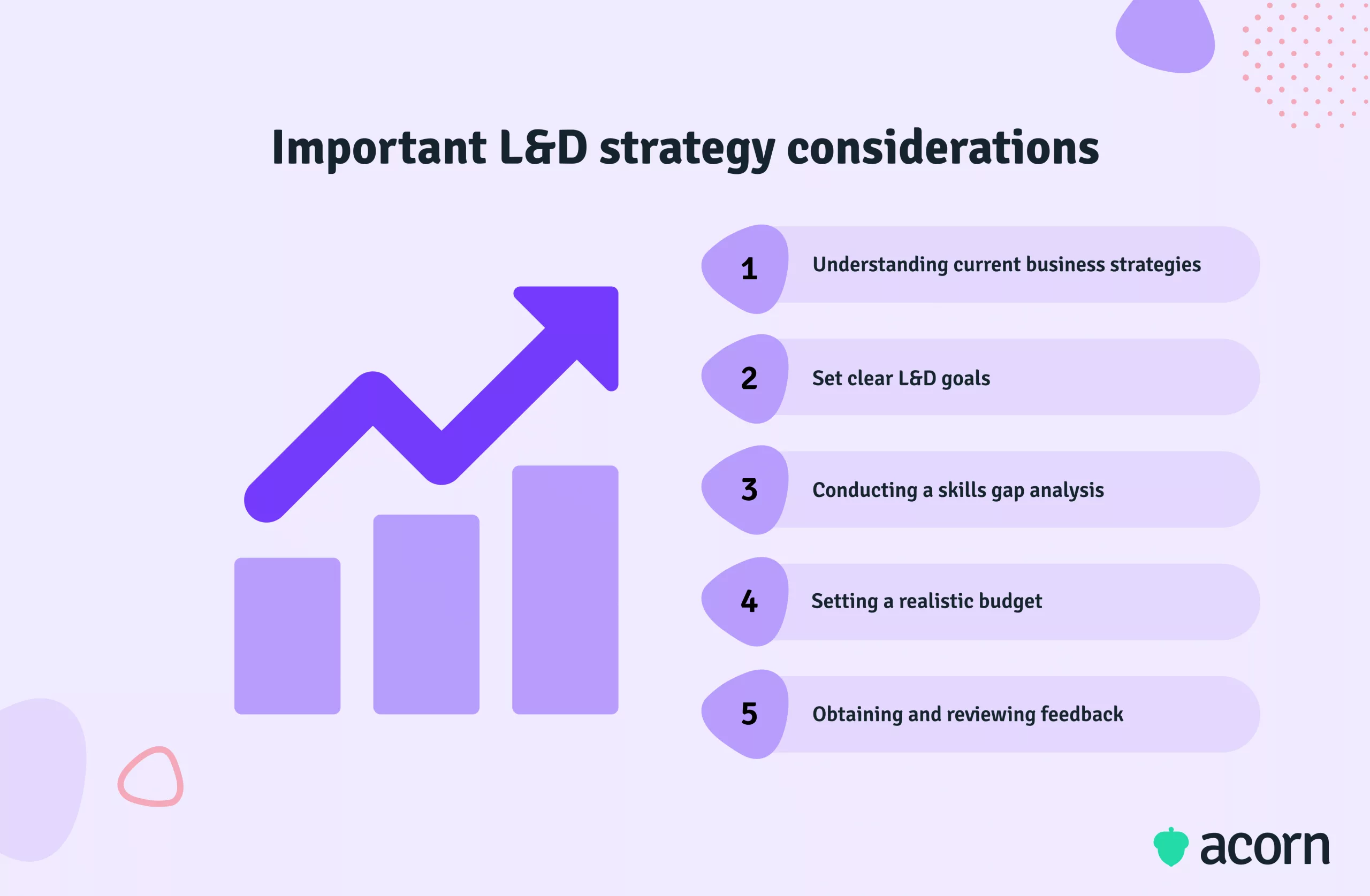Just Why Do Businesses Care About a Learning and Development Strategy Framework?
Reading Time:

Lead the pack with the latest in strategic L&D every month— straight to your inbox.
SubscribeMore and more L&D teams are building learning and development strategy frameworks. So, is it a trend, or do you need one?
In the past, L&D was mostly about the simple act of training employees for a better workforce. But in the wake of the global pandemic and subsequent increase in remote work, the attitude towards learning and development in the workforce has changed.
Let’s dive into what a learning and development strategy framework is and how it can benefit your business.
What is a learning and development strategy?
A learning and development strategy gives organisations the ability to create and provide training programs to employees in order to upskill and reskill them in alignment with organisational priorities and goals. Done well, L&D enables employees to acquire the necessary skills and knowledge to become as efficient and productive in their roles as possible.
Why are L&D strategy frameworks so popular?
Companies recognise that a learning and development strategy is one of the key factors to a successful business. The fact of the matter is that the future of an organisation lies in its workforce, and the future of the workforce is determined by the skills and adaptability of its individual employees. In short, if an organisation wants to keep a competitive advantage, they need to be investing in training their workers.
The origins of the L&D strategy framework
In the past, the L&D function has focused on training as a way to benefit the business specifically, rather than the individual workers. The focus was solely on the development of employee skills for certain job roles. Now, it’s all about a holistic view of the individual beyond just the technical skills the business requires of them.
Modern use of the L&D framework
While learning and development strategies have focused more on the formal training aspect in the past, these days L&D has broadened its horizons. Today’s learning and development programs cover training as well as a focus on building a workforce that is both inclusive and dynamic. This is partly the result of the global pandemic forcing a shift towards remote and hybrid working, pushing employers to keep their entire workforce engaged and motivated.
What’s more, skills and knowledge now have a shorter shelf-life than ever, and the only way to keep that knowledge up-to-date is to learn, adapt and grow.
Why businesses are implementing L&D strategy frameworks
An L&D strategy framework isn’t just about ensuring your employees get the training to know how to do their jobs. It’s about building a working environment that is knowledgeable, curious and inclusive. It’s also about using your workforce’s proficiencies to drive business successes by delivering on learning and development needs.
This is why we’ve developed the first performance learning management system (PLMS) here at Acorn. It’s a dynamic AI-powered platform for Learning and Development (L&D) experiences synchronized to business performance. In other words, it codifies and operationalises capabilities to improve organisational efficiency and assist in building and implementing your learning and development strategy.
Let’s dive into some of the factors leading to the implementation of learning and development strategy frameworks in businesses today.

- Employee retention
- Employee empowerment
- Workplace relationship building
- Overall business strategy
- Internal performance
- Cost reduction
Employee retention
In the modern climate, employees are more likely to look for a workplace which provides opportunities in learning and development. The days of working in one company for one’s whole career are gone.
Now employees seek out new career experiences and professional development from a variety of places. These days, not having any options for workplace learning and personal career development in your company is one of the main reasons people choose to leave.
Employee empowerment
This is part of “why” effective learning strategies lead to greater employee retention. No one wants to be in a job they hate or find boring, so making sure your employees are engaged in their work and professional development increases their fulfilment in their role. Research has even shown that lifelong learning increases happiness. Encouraging informal learning throughout the day helps to foster curiosity and build a positive learning environment by empowering employees to learn new skills. It doesn’t hurt that increases their productivity in the process.
Workplace relationship building
L&D can help a business build a workplace culture based on organisational values and a sense of community among its workforce. This is especially important now in the wake of the shift towards remote work, as employees are less likely to meet face-to-face and build rapport with each other as a result of proximity.
Overall business strategy
If you want to maintain a competitive advantage in the market, you need to make sure your organisation is constantly adapting to change and preparing for the future. Your business strategy should support your organisation as it enters that future. Unfortunately, not every business is able to deliver on their organisational goals, with only 40% of businesses reporting that they’ve aligned their L&D strategy with business strategy. L&D provides your workforce with the knowledge and skills needed to reach those business goals.
Internal performance
It’s no secret that providing your employees with learning and development opportunities to improve their skills, proficiencies and knowledge-base is a key factor in increasing their confidence and motivation in their role. And, unsurprisingly, a boost in confidence and motivation leads to a boost in another important aspect: performance. This means your project teams will be more efficient, and, by extension, so will your business. (Plus, performance management is a whole lot easier for managers with those learning outcomes to use as KPIs and benchmarks.)
Cost reduction
While it’s a no-brainer that training employees costs money, a good L&D strategy will actually help in reducing costs in the long run. There are a number of steps you can take to keep the costs of your L&D function low, from training your employees with internally produced training materials to picking a learning management system that can host specific and relevant learning to your workforce.
Simply put: When employees are skilled at their jobs, they become more efficient. And the higher the efficiency of your workforce, the lower the costs will be.
The risks of not implementing an L&D strategy framework
What happens if you don’t implement an L&D strategy framework in your business? Let’s take a look.
If you don’t ensure your L&D function is aligned with your priorities, you can’t guarantee that your employees will actually have the right knowledge and skills to meet those priorities. What’s more, the amount of time and resources spent trying to save failed projects and scrambling last-minute to solve problems will end up costing your business more in the long run.
You also don’t want to be paying for frequent recruitment and onboarding programs on top of this. If your employees feel they aren’t getting effective or efficient learning opportunities, they’ll start looking elsewhere for employers who will offer them what they want. It’s hard to build a healthy workplace culture when colleagues don’t hang around long enough to get to know one another, just as it’s hard for workers to stay in roles they feel they lack the training to perform well in.
Important considerations for an L&D strategy framework
When it comes to using a learning and development strategy framework in your organisation, you need to consider which factors are important for implementation.

Understanding current business strategies
The essential purpose of L&D is to serve the organisation and its business goals. Your learning and development strategy should support your organisation’s workforce in gaining the skills and proficiencies needed to reach your desired organisational outcomes in a timely and cost-effective manner.
Set clear L&D goals
Now that you know what your business goals are, you can decide which L&D goals you want to set. These goals should be quantifiable outcomes that need to be met for your business priorities to have been achieved.
Conducting a skills gap analysis
Once you know what business objectives you’re aiming for, you can look into what your workforce will actually need to do to meet them. A skills gap analysis will identify the gap (i.e. which skills are missing) between the skills your workforce will have in order for your priorities to have been met, and the skills your workforce currently possesses. This will help to show which skills and proficiencies in particular you will need to provide training for.
Setting a realistic budget
The beauty of L&D is that you can prove the impact your employees’ learning has on your business. Once you know:
- The value that learning brings to your organisation
- The productivity of your workforce, and
- The skills data you have collected from your gap analysis
Then you can determine and allocate appropriate learning and development budgets that will drive the learning outcomes you want.
Obtaining and reviewing feedback
To understand the impact and effectiveness of a learning and development strategy, you should measure its success with key performance indicators (KPIs).
- Business alignment: Measures how closely and effectively L&D actions are aligned with business priorities and goals.
- Learning impact: Measures whether L&D actions have changed the performance and behaviours of employees, in terms of proficiencies, built skills and values.
- Operational excellence: Measures how effectively resources are being used in the business.
You want to have an accurate measurement of L&D function on your business, so that you have an understanding of how effective your learning impacts are.
Key takeaways
When it comes to implementing a learning and development strategy framework, there is no better time than the present. The evolution of L&D strategy over the years has resulted in a learning strategy that benefits your performance and overall organisational health.
For many companies, implementing an L&D strategy framework is a significant factor in retaining staff and keeping your workforce up-to-date and ahead of the game in terms of skills and proficiencies. It’s a key driver behind maintaining a competitive advantage over your opponents.